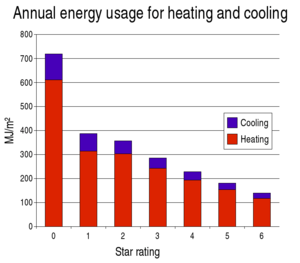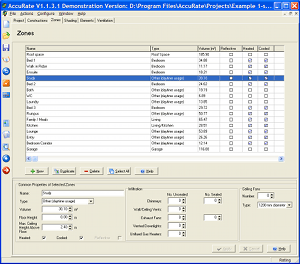House Energy Rating
A House Energy Rating is the index of a building's thermal performance (i.e. heating and cooling requirements) for residential homes in Australia.

The Australian Building Codes Board introduced energy efficiency measures for houses into the Building Code of Australia (BCA) on 1 January 2003. It has been adopted by all Australian states and territories which did not already have an equivalent system in place. Victoria and South Australia have gone beyond the standard, and mandated, instead of 4-stars, a 5-star rating (enacted July 2004) – all new homes and apartments built in Victoria must since 2010 comply with the 6 Star standard. This means it is compulsory for new houses to have:
- 6 Star energy rating for the building fabric, and
- A rainwater tank for toilet flushing or a solar hot water system, and
- Water efficient shower heads and tapware.
During 2006, requirements for 5-star energy ratings were introduced for new homes through the BCA in Western Australia and the Australian Capital Territory. As of mid-2007 Tasmania and the Northern Territory have not adopted 5 star requirements for new homes. As of 2010, Queensland has adopted 6-star requirements for new homes.[1] New South Wales has not adopted requirements under the BCA and operates its own Building Sustainability Index or BASIX. Victorian consumers and building practitioners can find out more about the 5-Star energy ratings by visiting Make Your Home Green – Building Commission
Ratings

6-Star rating
A 6-Star rating indicates that a building achieves a higher level of thermal energy performance than, say a 5 star rating. As of November 2011, 6-Star equivalence is the current minimum requirement in most of Australia.
5-Star rating
A 5-Star rating indicates that a building achieves a high level of thermal energy performance, and will require minimum levels of heating and cooling to be comfortable in winter and summer. Houses which achieve a 5 star rating, compared to the average 2 star home,[2] should be more comfortable to live in, have lower energy bills, and costs to install heating and cooling equipment should also be lower.
Energy assessments take into account different climatic conditions in different parts of the country and are benchmarked according to average household energy consumption particular to a given climatic region.
The house energy rating does not currently include the efficiency of any appliances fitted or used within the house. There are also no physical testing requirements, so air tightness testing is not required as it is with the regulations in the UK.
State Government initiatives
- ACT House Energy Rating Scheme (ACTHERS),[3] requires new or previously lived in residential homes to have an Energy Efficiency Rating (EER) Statement, prepared by an accredited ACTHERS assessor, if they are to be sold. As of the February 2006, the required software used in assessment is FirstRate, Version 3.1 or Version 4.[4]
- In Victoria all new homes built since 2005 are required to achieve a 5 Star rating.[5] Rating can be performed using any software approved by NatHERS.
- In South Australia, all new homes (and alterations to existing homes) are required to achieve a 6 star rating. This requirement was introduced on 1 September 2010.[6]
- Western Australia: in 2007 the WA Government introduced further energy and water usage regulatory requirements. 5 Star Plus consists of two codes: the Energy Use in Houses Code, which requires a minimum standard of energy performance for a hot water system; and the Water Use in Houses Code, which includes provisions for alternative water supplies, efficient fixtures and fittings, and grey water diversion.
- In Queensland it is proposed that from either 1 January 2009, or when the Building Code of Australia 2009 update is released in May 2009, that all new homes built in Queensland will be required to achieve a 5 star energy equivalent rating. Currently the minimum requirement is 3.5 stars.
Software

One of the best ways to achieve an energy rating on a proposed house is by using House Energy Rating Software (HERS). This kind of software will simulate a home and provide estimates for the energy needed to heat and cool that home over the course of the year.
The Nationwide House Energy Rating Scheme (NatHERS) is a framework by which this kind of software is assessed, compared and accredited for use in Australia.
The First Generation of accreditation included the FirstRate 4, BERS 3.2 and NatHERS software packages, allowing accredited assessor to use this software to provide energy ratings.
The Second Generation of accreditation was tightened and improved, meaning that software had to become more precise, accurate and powerful in response. The Second Generation of software must take into account more features and realistically model elements such as natural ventilation, the cooling effects of ceiling fans, under-floor heating and the effects of attached dwellings such as apartments.
The First Generation has been phased out for the Second Generation of software to take over.
In Victoria, the First Generation of software was no longer acceptable for energy ratings after 30 April 2009. FirstRate is the software package developed by Sustainability Victoria. Over the course of 2008, Sustainability Victoria has produced a new version, FirstRate 5.
FirstRate 5 received provisional Second Generation accreditation on 31 August 2007. This means that it can be used for house energy ratings now. From May 2009, it will be the only version of FirstRate accredited for use in Victoria. FirstRate Five uses the AccuRate calculation engine with a graphic interface. It includes: the ability to zone the house according to how each room will be used, the ability to rate up to 10 stars and the full range of AccuRate climate zones (69 in Australia).
Other Second Generation software acceptable for use in Victoria now and after 30 April deadline includes BERS Professional and AccuRate. AccuRate shares a calculation engine with FirstRate 5 but has a more complete data input method which allows for more precise energy ratings but lacks FirstRate5's graphic interface. Each software package will be appropriate in different circumstances.Nationwide House Energy Rating Scheme (NatHERS) - Home Page
Controversies
- The rating system does not consider factors such as sustainable materials, embodied energy, electricity sources, rainwater capture, local vegetation and access to public transportation.
- Some say that Carbon emissions would be a better metric to use compared to raw MegaJoules of Energy consumption.
- Inaccurate representation of the building in the software can result in an inaccurate assessment of the building's thermal performance. An unskilled or inexperienced assessor can easily make incorrect assumptions. Some states require in-depth training & accreditation for all assessors before they are considered qualified to use the software, while other states merely highly recommend (but not require) in-depth training & accreditation.
- While not a fault of the software itself, a building is often not constructed as drawn on the plans and some items (weather sealing, insulation values,[7] window coverings, paint colours, etc.) are often different from what was originally simulated. In other unintentional cases, items are installed but are installed incorrectly in a way that compromises their thermal performance (such as foil-based insulation without an air gap).
- In rare cases, certain styles of buildings in certain climates have become very difficult to comply without using expensive materials (such as a house on the side of a hill with solid glass walls along three sides, to provide ample viewing of the natural scenery). While most buildings can still find a solution without any major design alterations, sometimes this is only possible with expensive materials and this drastically increases the price of the house. This is usually an indication that the building was designed with aesthetics taking a prominent position over the comfort & livability of the occupants.
- The rating system does not deal with problems beyond a single household such as urban sprawl, city planning, etc. Comparative energy audits of high-rise accommodation and free-standing homes would enable planning authorities to better understand what form of accommodation is more economic and energy efficient.
- The rating system does not account for air-tight buildings with or without heat exchange units and is predominantly aimed toward the use of traditional building materials and does not open doors for newer higher quality building materials.
History
The Five Star Design Rating (FSDR) was an award developed in the 1980s for "high efficiency through excellence in design and construction" which assisted builders in marketing energy efficient home designs. The certification was developed by the Glass, Mass and Insulation Council of Australia (GMI Council) together with CSIRO Division of Building Research. The GMI Council was funded by Federal and State governments (NSW, SA, Tasmania, Victoria) and by private investors.[8]
Under FSDR, the basic elements of glass, mass and insulation were the basis of the design principles of a five star home.[9] The building industry did not widely accept the system due to its simple pass/fail rating and its restrictive guidelines.[10]
In the 1990s, individual states developed their own schemes. The Victorian scheme, based on a computer program, was eventually accepted as the most effective. However, it worked poorly in warm humid climates such as found in Queensland. The development of a nationwide House Energy Rating Scheme (NatHERS) began in 1993, based on the Victorian scheme, using the CHEETAH / CHEENATH engine developed at CSIRO. Software products NatHERS, FirstRate and Quick Rate, BERS, Q Rate and ACTHERS are based on this engine. NatHERS and BERS run the engine directly, while others use correlations based on the engine.[10]
See also
- Green Star (Australia)
- ABSA (Australia)
- BASIX, (NSW)
- EnerGuide or Houses (Canada)
- National Home Energy Rating (UK)
- Home energy rating (United States)
- Energy conservation
- Environmental economics
- Green building
- Zero-energy building
- Low-energy house
- Passive house
References
- ↑ http://www.map-testing.com/content/info/menu/map-testing-protocol.html
- ↑ "Make Your Home Green: 5 Star Standard". Retrieved 8 February 2010.
- ↑ "Energy ratings". 26 August 2014.
- ↑ http://www.planning.act.gov.au/topics/design-and-build/design-and-siting/energy_ratings
- ↑ "Make Your Home Green: 5 Star Standard". Retrieved 8 February 2010.
- ↑ "Energy Efficient Housing". Planning SA. Retrieved 8 March 2011.
- ↑ "Energy Efficiency Division". Pure Eco Magazine. 2011-10-17.
- ↑ Energy Efficient Building Design, Resource Book. 1992. Holger Willrath. Brisbane Institute of TAFE. Unit 1.
- ↑ Ballinger, J. A. (1998). The Nationwide House Energy Rating Scheme for Australia (BDP Environment Design Guide No.DES 22). Canberra: The Royal Australian Institute of Architects.
- 1 2 Development of a new framework for a House Rating Scheme (HRS) Maria Kordjamshidi. August 1997. University of New South Wales. "Archived copy". Archived from the original on 4 October 2008. Retrieved 16 September 2008.